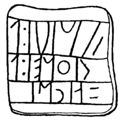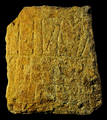TI·29
| Inscription | |
|---|---|
| Reading in transliteration: | ]ạniui : p[ / ]ḳionei : p[ / ]ẹ?ịọṇụ??[ |
| Reading in original script: | ] ] ]?? |
|
| |
| Object: | TI·29 Aranno (stela) |
| Position: | front |
| Frame: | ? |
| Direction of writing: | sinistroverse |
| Script: | North Italic script (Lepontic alphabet) |
| Letter height: | 10–15 cm3.937 in <br />5.906 in <br /> |
| Number of letters: | 18 |
| Number of words: | 6 |
| Number of lines: | 3 |
| Workmanship: | carved |
| Condition: | fragmentary |
|
| |
| Archaeological culture: | La Tène B, La Tène C [from object] |
| Date of inscription: | 4th–mid-2nd c. BC [from object] |
|
| |
| Type: | prob. funerary |
| Language: | Celtic |
| Meaning: | '... for °anios p° ... for °kiu p° ...' |
|
| |
| Alternative sigla: | Whatmough 1933 (PID): 272 a Solinas 1995: 1 A Motta 2000: 8 a Morandi 2004: 27 |
|
| |
| Sources: | Morandi 2004: 534 f. no. 27 |
Images
Commentary
First published in Mommsen 1853: 202 f., no. 5d.
Images in Mommsen 1853: Taf. I.5d (drawings by Vittore Pelli = CII: tab. I.1D a and b), Monti 1860: 59, no. 1 (drawing = CII: tab. I.1D c), CII: tab. LVIII.1D (drawing of a cast by Serafino Balestra ~ Oberziner 1883: 172 ~ Pauli 1885: Taf. I.1d ~ Giussani 1902: 33, fig. 3), Tibiletti Bruno 1990b: 81 (drawing). In great detail on the history of the documentation Tibiletti Bruno 1965: 103 f. with footnotes.
The middle parts of three lines are preserved on the fragment, each between frame lines which are shared (cf. TI·34.1/TI·34.2); no further letters appear to be visible above and below the outer lines. The letters in lines 1 and 2 are well legible, while the ones in line 3 are more damaged, making the reading uncertain. In lines 1 and 2, the elements before the separators are individual names in the dative (o-stem )aniui, on-stem )kionei, see the word pages for details), followed after the separators by a word beginning in p. p° in both lines could be pala (thus Motta 2000: 202, no. 8a; cf. the three inscriptions on the Tesserete stela with only individual names plus pala), though it cannot be excluded that either or both forms are patronyms beginning in ⟨p⟩ (cf. Tibiletti Bruno 1978: 136 f., 1997: 1015) – possibly those of brothers, who would bear the same patronym (Tibiletti Bruno 1978: 137), if the inscriptions in line 1 and 2 are associated (rather than the stone having been reused at a later date). As observed by Rhŷs 1913: 22 f., no. 7d, if )kionei is not a dative of an on-stem, but of an i-stem °kionis, the two people named in lines 1 and 2 could be husband and wife (cf. TI·36.1/TI·36.2).
See also Monti 1860: 59, CII: iii, no. 1d, Addenda et Corrigenda, c.2033, Corssen 1874–1875 I: 946 f., Oberziner 1883: 171 f., Pauli 1885: 8, no. 13d, 70–74, Giussani 1902: 33 f., no. 2, Tibiletti Bruno 1965, Tibiletti Bruno 1968c: 356, Tibiletti Bruno 1975 passim, Tibiletti Bruno 1990b: 90.
Bibliography
| CII | Ariodante Fabretti, Corpus inscriptionum italicarum antiquioris aevi. Ordine geographico digestum et glossarium italicum, in quo omnia vocabula continentur ex umbricis, sabinis, oscis, volscis, etruscis aliisque monumentis quae supersunt, Augusta Taurinorum: 1867. |
|---|---|
| Corssen 1874–1875 | Paul Wilhelm Corssen, Über die Sprache der Etrusker, Leipzig: Teubner 1874–1875. (2 volumes) |
| Crivelli 1943 | Aldo Crivelli, Atlante preistorico e storico della Svizzera Italiana. Vol. 1: Dalle origini alla civiltà romana, Bellinzona: Istituto Editoriale Ticinese 1943. |
| De Marinis & Motta 1991 | Raffaele C. De Marinis, Filippo Motta, "Una nuova iscrizione lepontica su pietra da Mezzovico (Lugano)", Sibrium 21 (1990–1991), 201–225. |

